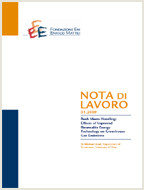The Equivalence of Strict Liability and Negligence Rule: A « Trompe l’œil » Perspective

10.02.2012
Gérard Mondello
K0, K32,Q01, Q58
Strict Liability, Negligence Rule, Ambiguity Theory, Uncertainty, Accident Model
Economy and Society
Giuseppe Sammarco
This paper analyzes the difficulties of comparing the respective effectiveness of two among the most important liability regimes in tort law: rule of negligence and strict liability. Starting from the standard Shavellian unilateral accident scheme, I show that matching up liability regime on their capacity to provide the highest level of safety is ineffective. This demonstration lies on two components. The first one gathers some results drawn from literature that introduces uncertainty. The second one takes into consideration the beliefs of agents and their aversion to ambiguity. The model applies uncertainty to the level of maximum damage. This demonstration reinforces the previous result. Hence, both regimes apply on specific tort question and comparing their individual efficiency needs to call for other components as the transaction costs associated to the burden of evidence, the fairness between victims and injurers, etc.
